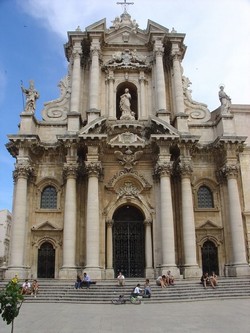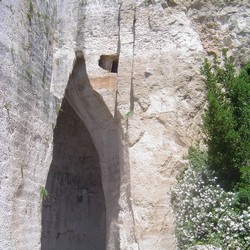Our tour will start by picking you up from your location, Visit the Monumental Park of the Neapolis: the Greeck Theatre, Dionysius' Ear, the Roman Amphitheatre, the Altar of Hiero. We will go to the Island of Ortigia : the Cathedral, the Fountain of Arethusa and the Temple of Apollo. Stop for lunch in restaurant than depart for Catania, orientation tour of the city and return to Taormina along the Coast of the Cyclops ( Acicastello - Acitrezza ).
Founded in 733 BC by colonists from Corinth on the island of Ortygia (now Ortigia), which means the place of quails in Greek, the Syracusans found the mainland a rich land to farm, and they linked the island to it with a causeway. Gelon became tyrant in 485 BC when he took advantage of an appeal for help from opponents in the city to the nobles who were ruling at the time. He remained in power until 478 BC, making an alliance with Akragas, defeating the Carthaginians in 480 BC, increasing the navy and building (a new agora, improvements to the temple of Apollo, building the temple of Athene which is incorporated into the Cathedral today) which the spoils of war.
Aeschylus probably put on some of his tragedies at the festivals in the theatre. Gelon, like Theron of Akragas, was celebrated in Pindar’s verse for his victory in the chariot races of the pan-Hellenic games. After Gelon’s death, his brother Hieron held power until 466 BC, defeating the Etruscans in a naval battle off Cumae in south Italy.
After Hieron the city adopted democracy. Syracuse was by now the most powerful city of all Sicily and a force to be reckoned with in south Italy. In the Peloponnesian War, she sided with Sparta and Corinth, her mother city, against the naval superpower of the Greek world, Athens. When Athens sent a fleet under Nikias and Demosthenes in 415 BC, the Syracusan commander extended the fortifications to the newer parts of the city. Gylippos eventually blockaded the Athenian fleet in the bay of Syracuse and defeated it in a desperate last sea battle.
After that, the Athenian survivors tried to escape by land but were killed or captured. Those who survived were forced to work in the terrible conditions of the stone quarries.The Athenian historian of the time, THUCYDIDES describes the events of the campaign in moving detail, in Book 7 of his History. Carthage soon moved against the Sicilian cities, and the new tyrant, Dionysius, who ruled 405 – 367 BC, strengthened the defences on the heights over the city (epipolai).
He did not drive the Carthaginians from the island, but managed to keep them at bay. For PLATO’s visit. Dionysius II who ruled 367 -343 BC, was hated by the Syracusans for his oppressive rule and appealed for help to Corinth, which sent Timoleon. Amazingly, he rid the island of its tyrants and liberated the cities in a few years, dying at Syracuse in 336 BC. Then there was civil war for years, with different groups struggling for power. Agathocles, a successful commander, gained control in 317 BC and made himself King. The Carthaginians attacked again in 278 BC, so the city appealed to Pyrrhus of Epirus for help.
He drove the enemy back, but when he left the island, the Carthaginian threat returned. Hieron, a Syracusan general who defeated the city of Messana (Messina today) was made king by the people of Syracuse, and he ruled well from 265 to 215 BC, as Hieron II. When Messana appealed to help to the growing power of Rome, and the First Punic War started, Hieron at first resisted them with kept Syracuse independent under his rule, as allied of Rome. Rome took control of the rest seating area, naming Zeus Olympios, King Hieron, his wife Philistis, Nereis the wife of Heron’s son Gelon. As his son married Nereis in 238, this helps to date Hieron’s work on the theatre. At the top of the theatre there are niches where votive offerings were found commemorating heroes of the area (the Greeks worshipped powerful warriors of the past, who were thought to help in times of danger, or respond to an individual appeal, especially near their tombs).
The theatre was altered again in Roman times, making it more like a semicircle than the usual Greek shape with a large dance floor (orchestra) for the chorus of the plays. Plays are put on here in alternate years, in summer. Hieron II built the great altar of Zeus where public offerings of 400 bulls could be made at a time. When the Second Punic War started, Hieron offered the support of Syracuse to Rome, but after is death at the age of 90 he was followed as king by his grandson Hieronymous, who reversed his policy and made an alliance with Carthage, so the Roman consul Marcellus besieged the city.
After a long siege, in which Archimedes devised ingenious methods of destroying the enemy ships, the Romans took the town. Under Roman occupation Syracuse was governed by such varied officials as Verres, who further despoiled it, and Cicero, the accuser of Verres. Saint Paul stayed three days at Syracuse on his way from Malta to Rhegium. Its later history is a tale of a rapid decline, though the Emperor Constance 7th resided in Syracuse in 662-68. It was destroyed by the Saracens in 878, and though freed for a time by George Maniakes 1038-40, the General of Basil II of Byzantium, who drove the Saracens out of the island, it was never again of much account. The temporary importance Syracuse regained from 1361 to 1536 as the quasi- independent seat of the “Camera Reginale”, was not maintained and in 1837, having rebelled unsuccessfully against the Bourbons, it even ceded for a time to Noto, its rights as a provincial capital.
During II World War was a target first for the Allied Air Forces and, after the capture on 10th July 1943, for German aircrafts, havoc was caused in the docks, but the slight damage done to important monuments is today scarcely traceable.
- THE ARCHEOLOGICAL AREA -
The Greek
Theatre
Archeological evidence
confirms the existence on this spot of a wooden theatre as early as the 6th century BC and here it was that Epicharmus, (about 540-450BC), worked as a
comic poet. The theatre probably dates from the 5th century BC and
was designed by the architect Democopos. Hieron Ist constructed a
small stone theatre with trapezoidal orchestra.It was enlarged under Timoleon
by excavating deeper into the hillside; it was again enlarged under Hieron II
(230BC), by extending the cavea upward. Under the Romans the scene was adapted
to baser uses and in the late Imperial period the orchestra was flooded for the
production of naval battles. It is one of the largest Greek theatres, 453
ft in diameter; the Athens theatre is 328 ft and the theatre at Delphi is only
164 ft. The theatre played an important role in the life of the ancient
Syracuse. Aeschylus staged a number of his plays there ( among the Persians in 472BC).It was also the site of the people assembly. The cavea, with its 66
rows of seats, could hold 15000 spectators. It is divided horizontally into two
parts by a “diazoma”, or ambulatory, and vertically into nine sections. These
bear the name of divinities and members of the ruling family.
The Ear of
Dionysius ( In Latomia del Paradiso )
The Latomie were Quarries from which the Ancients extracted the stone
needed for building their monuments. Syracuse has five such quarries of which
the best known are the Latomie del Paradiso, ( which includes the “Ear of
Dionysius” and the Grotto of “Cordari”) and the Latomie dei Cappuccini. Unlike
conventional open quarries, the Latomie are a series of caverns. When parts of
them collapsed in the 1693 earthquake, they developed into luxuriantly
overgrown garden. The Ear of Dionysius is an artificial cave that narrows
toward the top to a shape resembling the upper part of the outer ear. It
is 213 ft long, 75 ft high and between 16 to 36 ft wide. The name Caravaggio
gave to the cave in 1588 alludes to a legend that, by placing his ear next to a
hole in the roof, the tyrant Dionysius could listen to the conversations of
this prisoners without his movement being heard by them.The cavern’s strange
acoustic properties still exist today and simple cumpling of a paper at the
entrance develops into an amplified echo at the back.
Altar of
Hieron II
The altar was built in the 3rd century for sacrifices by Hieron II. Its immense size, 653 ft long by 75ft
wide, testifies to the importance the city placed on the sacrifices, during
which priests would offer up animals as thanks to the gods for a military
victory. When democracy was proclaimed, the Syracusans slaughtered 450 oxen,
cutting their throats so that the blood spurted up on to the altar. The
foundations are all that remain today.
The Roman
Anphitheatre
Like the Greek theatre and the
altar of Hieron II the sheer size of the Anphitheatre (459 per 390 ft) is
impressive and despite its state of ruin, it reflects the importance of public
life during the Roman era.It has an elliptical shape that (apart from the
southern section) was hewn out of the rock in the 3rd or 4th century AD. Below the cavea you can see the access corridor or “vomitorium” and
the tunnel through which wild beasts came into the arena. The “podium”, or
Royal box, can still be seen in the centre of the cavea.
- ORTYGIA ISLAND -
The Temple
of Apollo
This is the most archaic of
Sicilian Greek temples. It was built at the beginning of the 6th century BC and dedicated to Apollon and Artemis. It belongs to the
first step of the Greek temple architecture. The columns are massive and set
close together; they were 17 along the sides and 6 on the façade.Today you
can only see a few of them and all monolithic. The “cella” was very long
and narrow. The temple was transformed throughout the centuries into several
buildings such as a Byzantine Church, an Arab mosque and under the Spaniards
into a barracks.
The Fountain
of Arethusa
It is a fresh water spring
next to the Ionian sea. It looks like a pond full of papyrus plants, the same
species than in Egypt. The fountain is related to the love-story of the Nymph
Arethusa and the river- god Alpheus.The myth tells that Arethusa was a beautiful
nymph who used to bathe in the waters of the river Alpheus. The river fell in
love with her and began to pursue her.She was on the poit of succumbing his
advances, when she implored Artemis protectress of virgins, to safe her.
Artemis then ordered the earth to open at the feet of the Nimph who
disappeared, crossed the sea, and reappeared in the guise of a fresh water
spring on the island of Ortygia. We are told that Alpheus dug an underground
passage beneath the Ionian Sea and pursued her all the way to Sicily, where
their two waters intermingled.

